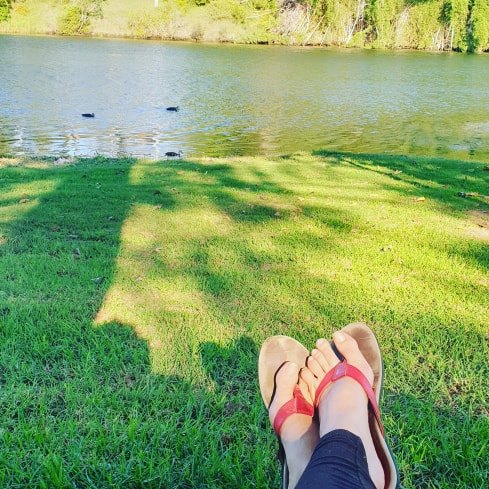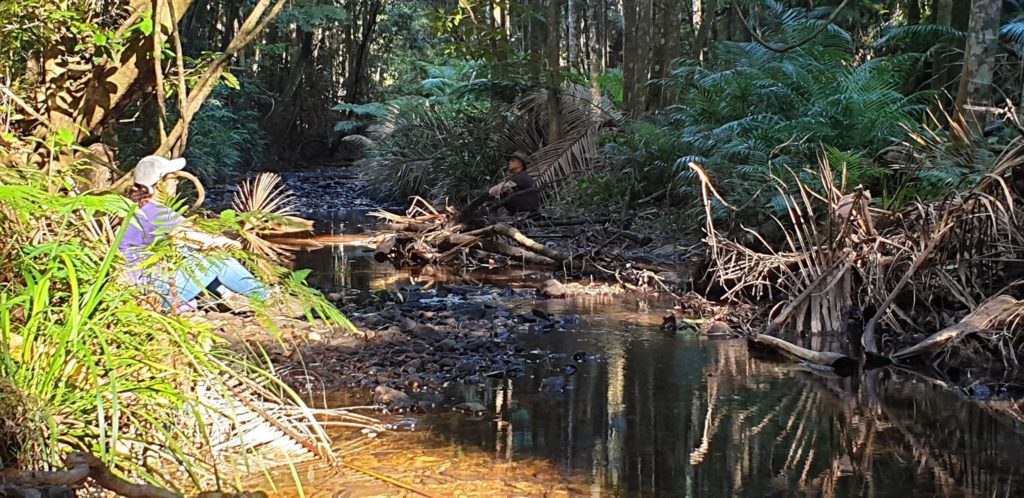I am writing this on the banks of the Macleay River in Kempsey. I feel a few gentle raindrops hitting the back of my neck. I smell the manure of the resident ducks wafting in the air. I hear the sound of the breeze whistling through pine needles. I see ripples of sunlight and reflection dancing over the water. I pick up a lonesome goose feather, run it across my cheek, and wince with the tickle. The cut grass feels prickly on the backs of my legs. This is mindfulness; what it feels like to be in the present moment, just noticing what is around me and the effect it has on my body.
I notice that which brings the most pleasure and choose to linger in those sensations a bit longer. Some would say we have lost the art of how to feel pleasure deeply, that somehow it is indulgent and we should move onto the next thing quickly for instant gratification.

In my mental health counselling practice, I come across a lot of people who struggle with meditation. They have been told to do it by well- meaning health professionals to cope with the stresses of daily life, anxiety or depression. But they often feel they can’t do it or at least sustain it. Some of us are just not born to sit still with our legs crossed on the floor humming a mantra. And the simple fact is, you don’t need to. The same kinds of relaxation and mind stilling effects can be gained by spending time in nature, mindfully and with intention. Nature helps us to turn our brains off and just be.
Often what brings people unstuck is the constant invasion of thoughts or feelings that arise during meditation. The voice of anxiety or depression definitely doesn’t want you to enjoy yourself. I know I struggled with this for many years, wondering if I was somehow doing it wrong or failing. I gave up and came back to it later in life when stress was impacting seriously on my health. Know that it is OK to have invading thoughts and feelings. Rather than push them away, welcome them. Then gently bring yourself back to the focus of your attention.
The focus of our attention does not have to be breathing, counting to ten, or repeating a mantra. It can simply be bringing your awareness to the natural environment using all your senses. Give yourself permission to enjoy that bird song, watch that butterfly, breathe that ocean air.
Let’s try it now. (You may like to record the following script on your phone, with gentle pauses or have someone guide you.)
I invite you to find a spot in nature where you can sit, stand or lie down without being interrupted. Allow yourself to just take in your surroundings and notice what is around you.
If you feel comfortable doing so, close your eyes. If not, you can lower your eyes to the ground and gently soften your gaze.
Take a moment to tune into your body. Notice if there is a part of you that is a bit tight or tense. Without making judgement, just give your body what it needs to feel relaxed. This could be a stretch, a deep breath, a wriggle or shake.
When you’re ready, bring your attention to the part of your body that is connected to the ground. Notice how it feels just to be supported by the earth. Notice the feeling of gravity and what it is like to be pulled gently towards the earth.
You may find that you are distracted by thoughts or feelings. This is okay. When you notice them, acknowledge them and let them float gently away again, like a leaf in the wind.
Now bring your attention to your sense of touch. Hold your hands out in front of you and notice the sensation of the air on your skin. You may like to explore the variety of textures on the ground around you. If there is a particular sensation of touch that feels pleasurable to you, invite it in for a minute.
Turning your attention to your hearing, notice what sounds are around you. Notice the variety of sounds, what is furtherest away, what is closest to you and what is filling the gap in between. You may notice the sounds are interacting with each other, like a chorus or symphony. Exaggerate the sound of your own breathing to see if you can blend it in with this rhythm. Perhaps there is a sound which is giving you the most pleasure. Allow it to penetrate your being.
Breathing in through your mouth, see if there is a taste to air. Notice the texture or quality of the air. If you’re feeling a bit cheeky, poke out your tongue and turn your head in different directions to see what changes. Breathing in through your nose, notice what smells are being offered. Move your head in different directions to notice what changes. Give yourself permission to linger longer in the smell that is giving you pleasure.
Before opening your eyes, imagine your eyes are like the sun popping over the horizon on a brand new day. When you are ready, open your eyes slowly, low at first and gently moving skyward. Notice what comes into your awareness.

You may like to reflect on what you are noticing about this kind of mindfulness meditation? What are you noticing in your body, in your mind, in your mood? What are you noticing in your surroundings that you have not observed before?
To me, a mindfulness practice in nature feels like ‘coming home’ to my true nature. It’s a way of being that has been practiced by our ancestors since time immemorial.
For more ways of being truly present in nature for good health and wellbeing, check out my Nature Therapy e-book. It’s free when you sign up to my newsletter.

